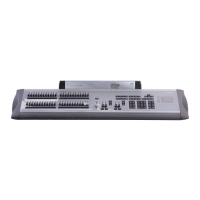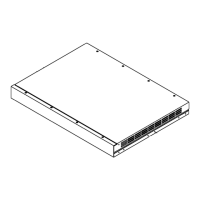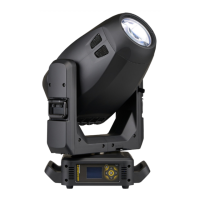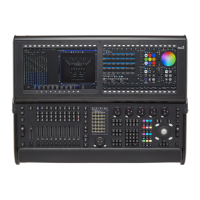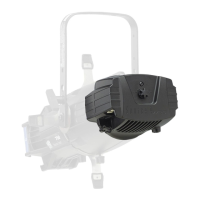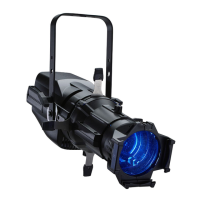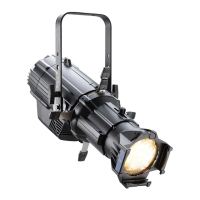Do you have a question about the ETC Express 48/96 and is the answer not in the manual?
How to navigate and understand the manual's structure and conventions.
Instructions for initial console setup and configuration.
Information on accessing context-sensitive help screens via console keys.
Explanation of formatting used for keys, messages, and references.
Describes how to move through menus and understand console feedback.
Explains HTP and LTP rules for determining channel output levels.
Defines key terminology and concepts related to moving light fixtures.
Explains how to use the 'Only' command to restrict selections during programming.
Details how to use the trackpad for setting rates and levels in different modes.
Information on preserving data via the electronic backup system and saving to disk.
Guidance on resolving issues and contacting ETC Technical Services for support.
Explains how display colors indicate channel status and output levels.
Describes the Stage display, showing active channel levels and global settings.
Explains the Blind display for working with cues without affecting the live look.
Details the Fader display for isolating channels by A/B or C/D fader pairs.
Describes the Flexichannel mode for displaying only used channels, reducing screen clutter.
Explains the Patch display for creating and modifying channel-to-dimmer assignments.
How to configure the total number of dimmers available in the system.
How to adjust the console's channel count to optimize performance and memory.
How to set default upfade and downfade times for all cues.
How to assign a default value to the [Level] key for channel level control.
How to set the default fade time for the [Clear] keys.
How to assign a default time for the sneak function.
Instructions on enabling or disabling the console's [Blackout] key.
How to switch between full channel display and Flexichannel modes.
Explains how to configure the Master slider's control options.
How to match console channels directly to submasters.
How to disable the Record function to protect the show from changes.
Instructions on enabling or disabling submaster bump buttons.
How to set the console's operating mode between one scene and two scene.
Procedures for setting the console's real-time and astronomical clock functions.
Displays information about the currently loaded show and memory usage.
How to apply the default one-to-one dimmer-to-channel patch.
Guide to configuring any dimmer-to-channel assignment.
How to scale dimmer output levels proportionally.
Assigning dimmers to channel zero for storage or re-patching.
Options to show or hide dimmer labels in the Patch display for more space.
Explanation of variable levels sent to dimmers during fades and available profiles.
Procedure for selecting and assigning a dimmer profile.
Procedure to raise unparked dimmers to a specified level for checking.
Displays characteristics, patch, and use of individual dimmers.
How to configure dimmers and ports for ETC's Dimmer Doubling technology.
Specific instructions for patching dimmers in a Strand CD80 rack.
Explains how channel color and behavior depend on their modes.
Shows settings for every console channel like Independent, Flip, 16-bit, LTP, Label.
How to edit channel attributes like independence and flip status.
Steps for selecting channels to modify their levels using the keypad.
Procedures for assigning output levels to channels using the basic format.
How to use the trackpad to set channel levels and output.
How the Flash key sets levels to 100% or zero, maintained only while pressed.
How to use the Sneak softkey to fade channels to a level or restore them.
Procedure to check which channel controls which light by flashing it to a level.
Displays information about channel characteristics, patch, and use.
Entry point for configuring moving light parameters.
Managing fixture personalities, including loading and viewing.
How to install fixtures in the Fixture Patch display.
How to edit or delete fixtures individually or in groups.
Customizing the assignment of fixture attributes to categories.
Changing the assignment of fixture attributes to level-setting devices and pages.
Principles for setting fixture attribute levels.
Using Solo to point or adjust selected moving lights without interference.
Describes Crossfade, Allfade, Effect, Blocking, and Subroutine cue step types.
Explanation of Record and Track functions for saving channel states.
Strategies for managing shows with more than 600 cues using segments.
Procedures for recording cues while working with live lighting looks.
How to create, preview, or modify cues without affecting the live look.
How to record cues with custom fade times.
Using Link to change cue playback sequence and Follow for automatic playback.
How to play back a cue, make changes, and re-record it.
How to modify recorded cues, groups, submasters, or focus points in Stage.
Procedure for deleting cues from memory in Blind or Stage.
How to use a cue's channel levels as a foundation for a new cue, group, or submaster.
How to insert a new cue between existing recorded cues.
Explanation of how Track record works for cues.
How channels track through cues and how Track adds tracks to subsequent cues.
Keystrokes to create tracks using the Record function.
How Record and Track produce different results when modifying cues.
How to make tracked channels track at a different level or use Track to pull levels.
How Record and Track handle inserting cues differently.
How blackout cues interact with tracking and how to block tracks.
Procedure for recording cues with up to eight parts.
How to reconfigure a single-part cue into a multipart cue.
How to set individual wait times for each part of a multipart cue.
How to add/delete parts, channels, modify levels, or change fade/wait times.
How to assign fade and wait times to multipart cue parts.
Ways to determine which cue will play next on stage.
Explanation of the console's two timed fader pairs (A/B and C/D).
Shows information about cues loaded to faders, including fade times and rates.
Steps to select a cue and play it on a fader of choice.
Procedure to play back a cue other than the one highlighted on the Cue List.
Ways to take manual control of cue playback using fader sliders.
Controlling fade rate and percentage of completion using the trackpad.
How to run through cues without waiting for fades, snapping immediately to completed levels.
Example illustrating group creation using newly selected channels.
Creating a group from the current look on stage.
Using Solo to selectively record into a group.
Explains Group mode and Group Editing mode for changing groups.
How to modify a recorded group in Stage and re-record it.
How to modify recorded cues, groups, submasters, or focus points in Stage.
How to assign labels to groups using Expression Off-Line.
Procedure to delete one or more groups from the Group List.
How to copy a group's look to another submaster, cue, group, or focus point.
Treating channels recorded in a cue or submaster as if they were in a group.
How to create focus points using Stage, Blind, or Fader displays.
Example illustrating focus point creation with fixture attributes.
Using Solo to selectively record attribute settings for moving lights into a focus point.
Procedures for placing and modifying focus points on stage.
How to modify recorded cues, groups, submasters, or focus points in Stage.
How to modify a focus point in Blind, such as adding/deleting fixtures or setting attribute levels.
Procedure to delete focus points from memory.
How to copy a focus point in Stage or Blind.
Using focus points as level-setting devices for fixtures or individual channels.
Describes Pile-on, Inhibitive, and Effect submaster types.
How to change a submaster's type using the [Type] key.
Explanation of the ten pages of submaster memory, allowing up to 240 submasters.
Functionality of the bump button located below each submaster slider.
Steps to create a simple, pile-on submaster.
How to add fade and dwell times to submasters.
How to record submasters that play back faster or slower than recorded fade times.
How to create and add channels to an inhibitive submaster to limit channel output.
Steps to modify a submaster's levels or attributes in Blind.
How to modify a submaster in Stage using Record.
How to modify recorded cues, groups, submasters, or focus points in Stage.
How to change the rate of an active submaster in Stage using the trackpad or keyboard.
Using the slider to take manual control of submasters recorded with fade times.
How to assign labels to submasters using Expression Off-Line.
How to copy a look from a submaster to another submaster, cue, group, or focus point.
How [Load Sub] allows loading contents of cues or groups into submasters.
Allows editing of cue attributes and deletion of cues.
Allows editing of bump button status, times, type, rate, and label.
Shows recorded groups by number and label, with options for paging, labeling, and deleting.
Shows all focus points by number and label, with options for paging, labeling, and deleting.
How to edit cues, submasters, groups, and focus points within their respective lists.
Introduces spreadsheets for managing cues, submasters, groups, and focus points.
How changes made in spreadsheets are recorded immediately.
How to reach the Park display and view parked channels/dimmers.
Procedure to park dimmers by specifying number and level.
How to unpark one or all dimmers.
How to park channels at levels from the keyboard or a focus point.
Linking parked channels to a focus point for automatic level updates.
How to unpark one or all channels.
How to park fixtures at levels set from the keypad or a focus point.
Procedure to unpark fixtures and revert attribute levels.
How to create or edit effects in the Blind Effects display.
Procedure for creating an effect in Blind.
How to create effects in the Stage display while viewing results.
How to set channel levels or add channels to steps using Update in Stage or Blind.
How to edit channel levels in a recorded effect cue, individually or in ranges.
Procedure to delete channels from a previously created effect step.
How to insert a new step into an effect, renumbering subsequent steps.
How to set effect attributes like Positive/Negative, Alternate, Reverse, Bounce, Build, Random.
How each effect has overall upfade, dwell, and downfade times.
How to control the range of randomness for an effect's rate.
How to play back effects recorded as cues.
All subroutine steps are either cue steps or style steps.
Describes Crossfade, Allfade, and Blocking cue step types.
Describes Loop, Bounce, Jump-to-cue, and Hold-for-Go playback styles.
Attributes that may be applied to each cue step (Level, Fade times, Follow time).
How to create subroutines in the Blind display, with up to 100 steps.
How to edit a subroutine by selecting steps and using softkeys or console controls.
How to delete a step from an effect, causing subsequent steps to be renumbered.
How to insert a new step into an effect, taking the place of a selected step.
Two ways to create macros: Macro Editing mode or Learn mode.
How to create a macro by performing an actual sequence of keystrokes.
How to create or edit macros in Insert or Replace modes.
How to program a pause in a macro where you want the pause to occur.
How any macro may end with a link to another macro for automatic sequence execution.
How submaster bump buttons can function in macros in three different ways.
How to run macros and the LED indication when a macro is running.
How to run a macro automatically each time the console is turned on.
Describes how channels are linked for simultaneous trackpad control.
Procedure to assign channels to the X and Y lists for trackpad control.
How to insert an empty link number ahead of a selected or specified link.
How to renumber a link or group of links, or move a link to an empty space.
How to add channels from a moved link to an existing link.
How to remove a link from the Link List, renumbering subsequent links.
How to control linked channels simultaneously on the trackpad.
Information on saving shows to diskette for backup and transfer.
Procedure to format a diskette on the console or an IBM PC.
How to write a showfile to diskette.
Procedures to read show, configuration, or both from diskette.
Verifying printer installation and using the Print Functions menu.
General steps for performing any printout from the Print Functions menu.
List of all 17 printout options and their explanations.
Explanation of how each option on the Clear Functions menu erases information.
General procedure for performing clears and resets using the Clear Functions menu.
List of all 14 clear/reset options and their functions.
Procedure to set the console's operating mode between one scene and two scene.
Explanation of how the A/B faders control scenes in two scene mode.
How the display shows current scene levels and timed crossfade information.
Steps to create scenes and run a show using manual crossfades.
Using A/B fader controls to run timed crossfades between scenes.
Accessing the ETCLink Functions menu for dimmer monitoring options.
How to enable the console to work with the ETCLink network.
Categories of messages (fatal, secondary) and how they appear.
Procedure to control the display of ETCLink advisories.
Details on system status, ETCLink errors, racks online, etc.
Information about specified dimmer racks.
Information about individual dimmers.
How to monitor individual dimmer loads.
Procedure to record load information for dimmers.
Compares current dimmer loads with recorded loads.
How to clear recorded load information.
How to set dimmer levels at the rack or return them to normal operation.
Explains MIDI protocol and its support for MIDI Show Control and ETC MIDI.
Recognizes MSC commands like Go, Stop, Resume, Fire.
How to create programs that execute automatically based on time or conditions.
Console's response to time code protocols for event-based playback.
How to create time code programs via definition or Learn Mode.
How to add, change, or delete events in the Time Code Events display.
Ability to control up to 4 console macros remotely.
Information on the serial interface port for future implementation.
Programming macros to send On/Off signals to external devices.
Description and features of the portable remote control panel.
How to attach and use an alphanumeric keyboard for assigning labels.
Information on optional Littlite gooseneck console lights.
Software for creating/modifying programs offline on a PC.
Illustration and description of the console's rear panel connectors.
How to check and replace the external device fuse.
Step-by-step guide for setting up the console and its monitor.
Details on VGA monitor pinouts and connections.
Explanation of ETCNet and ETCNet2 networks and compatible devices.
Instructions for connecting the console to a network using twisted pair wiring.
Ensuring system software compatibility for network devices.
Procedures for upgrading console and remote interface software.
Steps to install new console software from diskette.
Procedures for upgrading software on remote interface units.
Options for upgrading software when version or CRC numbers do not match.
Information on RIU and RVI devices and their support.
Explanation of how to install jumpers on circuit boards.
Details on configuring the RIU's DIP switches and jumpers.
Procedure for inspecting and replacing RIU fuses.
Ports and accessories supported by the RVI.
How to enable RVI for ETCNet by setting DIP switches.
Connecting monitors to RIUs or RVIs for remote display duplication.
Instructions for networking older consoles using thinnet wiring.
Common errors encountered with diskettes and their solutions.
Categories of ETCLink messages (fatal, secondary) and their meanings.
Messages that could terminate or drastically change the show's look.
Messages dealing with dimmer problems and rack temperature warnings.
Information on settings within a showfile, categorized by display.
Configuration information included when reading a showfile.
Configuration information retrieved when reading system configuration from disk.
Items that represent the show's specific programming and settings.
Lists softkey functions available in the Stage display.
Lists softkey functions for Blind and Cue displays.
Lists softkey functions for Blind and Focus displays.
Lists softkey functions for Blind and Submaster displays.
Table listing US cities with their time zones, latitude, and longitude.
Table listing international cities with their time zones, latitude, and longitude.
Comparative table of Express 24/48, 48/96, and 72/144 models.
Electrical specifications including voltage input and maximum current.
List of interfaces supported by the console.
Maximum limits for cues, channels, groups, macros, etc.
Capabilities related to fader control, including fade times and manual override.
List of controls for playback operations like Go, Hold, Back, Rate, Clear, Submasters.
Features for managing timing via internal/external clocks and real-time programs.
Overview of available display modes and help features.
Capabilities related to submaster operation like pages, assignments, and LEDs.
Details on channel data types, precedence rules, group functions, and link lists.
Features related to moving lights including personalities, patching, attributes, and focus.
Capabilities for creating and managing cues, including multipart cues and effects.
Features related to group management, including count, access, and editing.
Features related to focus points, including count, access, and updating.
Capabilities related to diskette operations like storage, updates, and retrieval.
Features related to macro programming, execution, and editing.
Capabilities related to effects, including steps, timing, levels, and editing.
Features related to dimmer profiles, including assignment and editability.
List of optional accessories and controllers supported by the console.
Physical dimensions and weight for different Express console models.
ETC's warranty terms for original owners and retail customers.
Controlling terms and conditions for orders accepted by ETC.
How to navigate and understand the manual's structure and conventions.
Instructions for initial console setup and configuration.
Information on accessing context-sensitive help screens via console keys.
Explanation of formatting used for keys, messages, and references.
Describes how to move through menus and understand console feedback.
Explains HTP and LTP rules for determining channel output levels.
Defines key terminology and concepts related to moving light fixtures.
Explains how to use the 'Only' command to restrict selections during programming.
Details how to use the trackpad for setting rates and levels in different modes.
Information on preserving data via the electronic backup system and saving to disk.
Guidance on resolving issues and contacting ETC Technical Services for support.
Explains how display colors indicate channel status and output levels.
Describes the Stage display, showing active channel levels and global settings.
Explains the Blind display for working with cues without affecting the live look.
Details the Fader display for isolating channels by A/B or C/D fader pairs.
Describes the Flexichannel mode for displaying only used channels, reducing screen clutter.
Explains the Patch display for creating and modifying channel-to-dimmer assignments.
How to configure the total number of dimmers available in the system.
How to adjust the console's channel count to optimize performance and memory.
How to set default upfade and downfade times for all cues.
How to assign a default value to the [Level] key for channel level control.
How to set the default fade time for the [Clear] keys.
How to assign a default time for the sneak function.
Instructions on enabling or disabling the console's [Blackout] key.
How to switch between full channel display and Flexichannel modes.
Explains how to configure the Master slider's control options.
How to match console channels directly to submasters.
How to disable the Record function to protect the show from changes.
Instructions on enabling or disabling submaster bump buttons.
How to set the console's operating mode between one scene and two scene.
Procedures for setting the console's real-time and astronomical clock functions.
Displays information about the currently loaded show and memory usage.
How to apply the default one-to-one dimmer-to-channel patch.
Guide to configuring any dimmer-to-channel assignment.
How to scale dimmer output levels proportionally.
Assigning dimmers to channel zero for storage or re-patching.
Options to show or hide dimmer labels in the Patch display for more space.
Explanation of variable levels sent to dimmers during fades and available profiles.
Procedure for selecting and assigning a dimmer profile.
Procedure to raise unparked dimmers to a specified level for checking.
Displays characteristics, patch, and use of individual dimmers.
How to configure dimmers and ports for ETC's Dimmer Doubling technology.
Specific instructions for patching dimmers in a Strand CD80 rack.
Explains how channel color and behavior depend on their modes.
Shows settings for every console channel like Independent, Flip, 16-bit, LTP, Label.
How to edit channel attributes like independence and flip status.
Steps for selecting channels to modify their levels using the keypad.
Procedures for assigning output levels to channels using the basic format.
How to use the trackpad to set channel levels and output.
How the Flash key sets levels to 100% or zero, maintained only while pressed.
How to use the Sneak softkey to fade channels to a level or restore them.
Procedure to check which channel controls which light by flashing it to a level.
Displays information about channel characteristics, patch, and use.
Entry point for configuring moving light parameters.
Managing fixture personalities, including loading and viewing.
How to install fixtures in the Fixture Patch display.
How to edit or delete fixtures individually or in groups.
Customizing the assignment of fixture attributes to categories.
Changing the assignment of fixture attributes to level-setting devices and pages.
Principles for setting fixture attribute levels.
Using Solo to point or adjust selected moving lights without interference.
Describes Crossfade, Allfade, Effect, Blocking, and Subroutine cue step types.
Explanation of Record and Track functions for saving channel states.
Strategies for managing shows with more than 600 cues using segments.
Procedures for recording cues while working with live lighting looks.
How to create, preview, or modify cues without affecting the live look.
How to record cues with custom fade times.
Using Link to change cue playback sequence and Follow for automatic playback.
How to play back a cue, make changes, and re-record it.
How to modify recorded cues, groups, submasters, or focus points in Stage.
Procedure for deleting cues from memory in Blind or Stage.
How to use a cue's channel levels as a foundation for a new cue, group, or submaster.
How to insert a new cue between existing recorded cues.
Explanation of how Track record works for cues.
How channels track through cues and how Track adds tracks to subsequent cues.
Keystrokes to create tracks using the Record function.
How Record and Track produce different results when modifying cues.
How to make tracked channels track at a different level or use Track to pull levels.
How Record and Track handle inserting cues differently.
How blackout cues interact with tracking and how to block tracks.
Procedure for recording cues with up to eight parts.
How to reconfigure a single-part cue into a multipart cue.
How to set individual wait times for each part of a multipart cue.
How to add/delete parts, channels, modify levels, or change fade/wait times.
How to assign fade and wait times to multipart cue parts.
Ways to determine which cue will play next on stage.
Explanation of the console's two timed fader pairs (A/B and C/D).
Shows information about cues loaded to faders, including fade times and rates.
Steps to select a cue and play it on a fader of choice.
Procedure to play back a cue other than the one highlighted on the Cue List.
Ways to take manual control of cue playback using fader sliders.
Controlling fade rate and percentage of completion using the trackpad.
How to run through cues without waiting for fades, snapping immediately to completed levels.
Example illustrating group creation using newly selected channels.
Creating a group from the current look on stage.
Using Solo to selectively record into a group.
Explains Group mode and Group Editing mode for changing groups.
How to modify a recorded group in Stage and re-record it.
How to modify recorded cues, groups, submasters, or focus points in Stage.
How to assign labels to groups using Expression Off-Line.
Procedure to delete one or more groups from the Group List.
How to copy a group's look to another submaster, cue, group, or focus point.
Treating channels recorded in a cue or submaster as if they were in a group.
How to create focus points using Stage, Blind, or Fader displays.
Example illustrating focus point creation with fixture attributes.
Using Solo to selectively record attribute settings for moving lights into a focus point.
Procedures for placing and modifying focus points on stage.
How to modify recorded cues, groups, submasters, or focus points in Stage.
How to modify a focus point in Blind, such as adding/deleting fixtures or setting attribute levels.
Procedure to delete focus points from memory.
How to copy a focus point in Stage or Blind.
Using focus points as level-setting devices for fixtures or individual channels.
Describes Pile-on, Inhibitive, and Effect submaster types.
How to change a submaster's type using the [Type] key.
Explanation of the ten pages of submaster memory, allowing up to 240 submasters.
Functionality of the bump button located below each submaster slider.
Steps to create a simple, pile-on submaster.
How to add fade and dwell times to submasters.
How to record submasters that play back faster or slower than recorded fade times.
How to create and add channels to an inhibitive submaster to limit channel output.
Steps to modify a submaster's levels or attributes in Blind.
How to modify a submaster in Stage using Record.
How to modify recorded cues, groups, submasters, or focus points in Stage.
How to change the rate of an active submaster in Stage using the trackpad or keyboard.
Using the slider to take manual control of submasters recorded with fade times.
How to assign labels to submasters using Expression Off-Line.
How to copy a look from a submaster to another submaster, cue, group, or focus point.
How [Load Sub] allows loading contents of cues or groups into submasters.
Allows editing of cue attributes and deletion of cues.
Allows editing of bump button status, times, type, rate, and label.
Shows recorded groups by number and label, with options for paging, labeling, and deleting.
Shows all focus points by number and label, with options for paging, labeling, and deleting.
How to edit cues, submasters, groups, and focus points within their respective lists.
Introduces spreadsheets for managing cues, submasters, groups, and focus points.
How changes made in spreadsheets are recorded immediately.
How to reach the Park display and view parked channels/dimmers.
Procedure to park dimmers by specifying number and level.
How to unpark one or all dimmers.
How to park channels at levels from the keyboard or a focus point.
Linking parked channels to a focus point for automatic level updates.
How to unpark one or all channels.
How to park fixtures at levels set from the keypad or a focus point.
Procedure to unpark fixtures and revert attribute levels.
How to create or edit effects in the Blind Effects display.
Procedure for creating an effect in Blind.
How to create effects in the Stage display while viewing results.
How to set channel levels or add channels to steps using Update in Stage or Blind.
How to edit channel levels in a recorded effect cue, individually or in ranges.
Procedure to delete channels from a previously created effect step.
How to insert a new step into an effect, renumbering subsequent steps.
How to set effect attributes like Positive/Negative, Alternate, Reverse, Bounce, Build, Random.
How each effect has overall upfade, dwell, and downfade times.
How to control the range of randomness for an effect's rate.
How to play back effects recorded as cues.
All subroutine steps are either cue steps or style steps.
Describes Crossfade, Allfade, and Blocking cue step types.
Describes Loop, Bounce, Jump-to-cue, and Hold-for-Go playback styles.
Attributes that may be applied to each cue step (Level, Fade times, Follow time).
How to create subroutines in the Blind display, with up to 100 steps.
How to edit a subroutine by selecting steps and using softkeys or console controls.
How to delete a step from an effect, causing subsequent steps to be renumbered.
How to insert a new step into an effect, taking the place of a selected step.
Two ways to create macros: Macro Editing mode or Learn mode.
How to create a macro by performing an actual sequence of keystrokes.
How to create or edit macros in Insert or Replace modes.
How to program a pause in a macro where you want the pause to occur.
How any macro may end with a link to another macro for automatic sequence execution.
How submaster bump buttons can function in macros in three different ways.
How to run macros and the LED indication when a macro is running.
How to run a macro automatically each time the console is turned on.
Describes how channels are linked for simultaneous trackpad control.
Procedure to assign channels to the X and Y lists for trackpad control.
How to insert an empty link number ahead of a selected or specified link.
How to renumber a link or group of links, or move a link to an empty space.
How to add channels from a moved link to an existing link.
How to remove a link from the Link List, renumbering subsequent links.
How to control linked channels simultaneously on the trackpad.
Information on saving shows to diskette for backup and transfer.
Procedure to format a diskette on the console or an IBM PC.
How to write a showfile to diskette.
Procedures to read show, configuration, or both from diskette.
Verifying printer installation and using the Print Functions menu.
General steps for performing any printout from the Print Functions menu.
List of all 17 printout options and their explanations.
Explanation of how each option on the Clear Functions menu erases information.
General procedure for performing clears and resets using the Clear Functions menu.
List of all 14 clear/reset options and their functions.
Procedure to set the console's operating mode between one scene and two scene.
Explanation of how the A/B faders control scenes in two scene mode.
How the display shows current scene levels and timed crossfade information.
Steps to create scenes and run a show using manual crossfades.
Using A/B fader controls to run timed crossfades between scenes.
Accessing the ETCLink Functions menu for dimmer monitoring options.
How to enable the console to work with the ETCLink network.
Categories of messages (fatal, secondary) and how they appear.
Procedure to control the display of ETCLink advisories.
Details on system status, ETCLink errors, racks online, etc.
Information about specified dimmer racks.
Information about individual dimmers.
How to monitor individual dimmer loads.
Procedure to record load information for dimmers.
Compares current dimmer loads with recorded loads.
How to clear recorded load information.
How to set dimmer levels at the rack or return them to normal operation.
Explains MIDI protocol and its support for MIDI Show Control and ETC MIDI.
Recognizes MSC commands like Go, Stop, Resume, Fire.
How to create programs that execute automatically based on time or conditions.
Console's response to time code protocols for event-based playback.
How to create time code programs via definition or Learn Mode.
How to add, change, or delete events in the Time Code Events display.
Ability to control up to 4 console macros remotely.
Information on the serial interface port for future implementation.
Programming macros to send On/Off signals to external devices.
Description and features of the portable remote control panel.
How to attach and use an alphanumeric keyboard for assigning labels.
Information on optional Littlite gooseneck console lights.
Software for creating/modifying programs offline on a PC.
Illustration and description of the console's rear panel connectors.
How to check and replace the external device fuse.
Step-by-step guide for setting up the console and its monitor.
Details on VGA monitor pinouts and connections.
Explanation of ETCNet and ETCNet2 networks and compatible devices.
Instructions for connecting the console to a network using twisted pair wiring.
Ensuring system software compatibility for network devices.
Procedures for upgrading console and remote interface software.
Steps to install new console software from diskette.
Procedures for upgrading software on remote interface units.
Options for upgrading software when version or CRC numbers do not match.
Information on RIU and RVI devices and their support.
Explanation of how to install jumpers on circuit boards.
Details on configuring the RIU's DIP switches and jumpers.
Procedure for inspecting and replacing RIU fuses.
Ports and accessories supported by the RVI.
How to enable RVI for ETCNet by setting DIP switches.
Connecting monitors to RIUs or RVIs for remote display duplication.
Instructions for networking older consoles using thinnet wiring.
Common errors encountered with diskettes and their solutions.
Categories of ETCLink messages (fatal, secondary) and their meanings.
Messages that could terminate or drastically change the show's look.
Messages dealing with dimmer problems and rack temperature warnings.
Information on settings within a showfile, categorized by display.
Configuration information included when reading a showfile.
Configuration information retrieved when reading system configuration from disk.
Items that represent the show's specific programming and settings.
Lists softkey functions available in the Stage display.
Lists softkey functions for Blind and Cue displays.
Lists softkey functions for Blind and Focus displays.
Lists softkey functions for Blind and Submaster displays.
Table listing US cities with their time zones, latitude, and longitude.
Table listing international cities with their time zones, latitude, and longitude.
Comparative table of Express 24/48, 48/96, and 72/144 models.
Electrical specifications including voltage input and maximum current.
List of interfaces supported by the console.
Maximum limits for cues, channels, groups, macros, etc.
Capabilities related to fader control, including fade times and manual override.
List of controls for playback operations like Go, Hold, Back, Rate, Clear, Submasters.
Features for managing timing via internal/external clocks and real-time programs.
Overview of available display modes and help features.
Capabilities related to submaster operation like pages, assignments, and LEDs.
Details on channel data types, precedence rules, group functions, and link lists.
Features related to moving lights including personalities, patching, attributes, and focus.
Capabilities for creating and managing cues, including multipart cues and effects.
Features related to group management, including count, access, and editing.
Features related to focus points, including count, access, and updating.
Capabilities related to diskette operations like storage, updates, and retrieval.
Features related to macro programming, execution, and editing.
Capabilities related to effects, including steps, timing, levels, and editing.
Features related to dimmer profiles, including assignment and editability.
List of optional accessories and controllers supported by the console.
Physical dimensions and weight for different Express console models.
ETC's warranty terms for original owners and retail customers.
Controlling terms and conditions for orders accepted by ETC.
| Brand | ETC |
|---|---|
| Model | Express 48/96 |
| Category | Lighting Equipment |
| Language | English |
